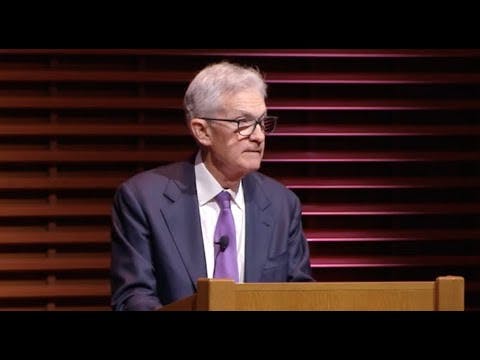Business Government and Society Forum Conversation with Jerome Powell, Federal Reserve Chair
()

Stanford Business School's Business, Government, and Society (BGS) Initiative
- Aims to address emerging areas of debate and prepare students for responsible leadership.
- Has generated new classes, conferences, workshops, research projects, and fostered partnerships across campus.
- Inaugural BGS Forum focuses on leadership responsibility and civil discourse, with Federal Reserve Chair Jerome Powell as the keynote speaker.
Federal Reserve's Monetary Policy and Economic Outlook
- Powell discusses progress in reducing inflation but emphasizes the need for continued tight monetary policy to achieve the 2% inflation goal.
- Despite recent higher-than-expected job gains and inflation data, Powell believes the overall economic picture remains positive, with solid growth, a rebalancing labor market, and inflation trending down.
- The Federal Reserve will maintain its current policy rate until there is greater confidence that inflation is sustainably moving towards 2%.
- Inflation has come down from 6-7% two years ago to 2.8% due to both the unwinding of pandemic-related distortions and the effects of tight monetary policy.
- Factors to watch in the future include the potential for further supply-side recovery, inflation expectations, and the impact of monetary policy on interest-sensitive spending and the labor market.
- Inflation expectations are currently aligned with the Federal Reserve's 2% target, supported by various surveys and market indicators.
- The strong labor market, with low unemployment despite rapid interest rate hikes, can be attributed to the unusual origins of the current inflation, which was partly independent of demand.
- The recovery in labor force participation, immigration, and the unwinding of supply chain issues have contributed to increased potential output, allowing inflation to come down without significant job losses.
- The Federal Reserve acknowledges the importance of immigration in addressing labor shortages but does not comment on immigration policies.
- The interest rate sensitivity of the economy has been muted in this cycle, with differential impacts across sectors.
- The housing market, with long-term fixed-rate mortgages, shows low interest rate pass-through, while early-stage growth businesses in Silicon Valley are more affected by higher capital costs.
- The Federal Reserve believes that monetary policy is working broadly as expected and is confident in its ability to balance the impact of interest rate hikes on different sectors.
- The US economy grew by 3.1% in a year despite high-interest rates due to a supply-side recovery that created new demand and supply.
- The Federal Reserve's policy rate is at 5.3%, resulting in a 2.5% real interest rate compared to near-zero rates before the pandemic.
- The Fed's policy is considered restrictive, and the Taylor rule suggests that the policy rate should be around 4%.
- The Fed is maintaining a tight policy stance to balance the risks of cutting rates too soon and causing inflation to rise again, or waiting too long and causing a weakening in the labor market and economic output.
- The Fed does not have a single mandate and must consider both price stability and maximum employment, with a focus on the goal that is furthest from being achieved.
Long-Term Economic Growth and Challenges
- Long-term growth expectations for the US economy have shifted from 2.8%-3% before the pandemic to below 2% currently, due to low population growth and expectations of lower productivity growth.
- The recent higher productivity growth may or may not be sustained, and the impact of AI on productivity is still uncertain.
- The Federal Reserve's focus is on productivity, immigration, trade policy, and industrial policy for long-term growth and economic well-being.
- The neutral interest rate in the future is not a pressing concern for current policy.
Federal Reserve's Decision-Making Process and Leadership
- The Fed's pivot to address inflation in 2021 was necessary due to unexpected circumstances.
- External pressures on the Fed's decision-making process are managed through internal consensus and a focus on economic reasons.
- Building consensus involves sticking to the Fed's mandate, listening respectfully to different perspectives, and incorporating feedback into decision-making.
- Chair Powell's background in public service and diverse career experiences have helped him navigate the challenges of leading the Fed.
Career Advice and Leadership
- For students interested in moving between public and private sectors, it can be a great plan with different levels of volatility to consider.
- The speaker discusses their career path, which includes working in investment banking, private equity, and public service.
- They emphasize the importance of being willing to tolerate volatility and steep learning curves in order to succeed in different fields.
- The speaker highlights that there is no one-size-fits-all model for successful leadership and that different people can be successful in leadership roles in their own unique ways.
- They encourage individuals to have self-confidence in their abilities to lead, take risks, and take on challenges.